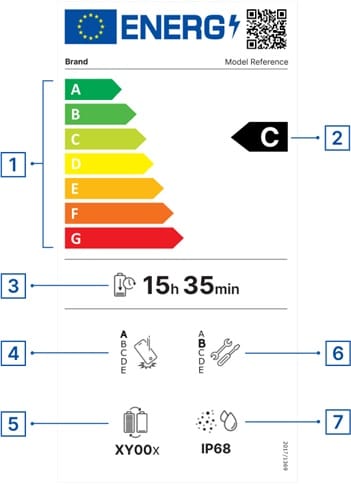In a significant move to boost sustainability and consumer transparency, the European Union (EU) has mandated a new energy label for mobile phones and tablets. Starting June 20, 2025, all smartphones, feature phones, cordless phones, and tablets sold within its borders must display the European Product Registry for Energy Labelling (EPREL) label. This marks a major evolution in tech product labeling, going beyond basic energy ratings to include detailed insights into battery longevity, durability, and repairability.
EU continues its push toward a new era of interoperable and transparent tech
The European lawmakers have been pushing tech companies to open up their ecosystem to smaller players. The latest energy label mandate continues this push toward a new era of interoperable and transparent tech. The EPREL label will replace the EU’s older ENERGY label format. It provides consumers with seven key performance indicators:
- Scale of energy efficiency (from class A to G)
- Energy efficiency class
- Battery endurance per cycle (in hours and minutes per full battery charge)
- Repeated free-fall reliability class
- Battery endurance in cycles
- Repairability class
- Ingress Protection (IP) rating
This initiative is part of the EU’s broader Ecodesign and Energy Labelling Regulations (2023/1670 and 2023/1669), aimed at minimizing the environmental footprint of consumer electronics while empowering consumers to make more informed purchasing decisions. Phones with flexible and rollable main displays are exempt from the new label, while it only applies to tablets with screen sizes from 7 inches to 17.4 inches.
The new rule enables consumers to compare devices based on how long their batteries last, how durable they are against accidental damage, and how easy they are to repair. For example, a smartphone must retain at least 80% of its original battery capacity after 800 full charge cycles to be considered compliant. Devices must also be resistant to drops and environmental factors like dust and water, and support professional repairers with access to software and spare parts for up to seven years after a model is discontinued.
Additionally, companies must provide OS updates for at least five years from the date a device is last sold in the region. Samsung already offers seven years of updates to flagship models and six years to mid-range devices. However, the counting begins from the launch, rather than the “last sold” date. This means the new EU regulations require rethinking design, materials, and support policies for manufacturers.
Environmental and economic benefits of the EU EPREL label
The new ecodesign requirements from the EU will extend the average smartphone lifespan from 3 years to 4.1 years. This means fewer devices sold annually, translating into a measurable drop in manufacturing-related emissions and resource consumption. According to estimates from the Ecodesign Impact Accounting Overview Report 2024, the new regulations will yield impressive benefits:
- Energy savings of 2.2 TWh annually by 2030, enough to power hundreds of thousands of households
- Consumer cost savings of €20 billion across the EU, primarily through fewer purchases due to extended device lifespans
- Reduction in greenhouse gas emissions, as longer-lasting devices reduce production needs and electronic waste
By pushing for devices that are more efficient, durable, and easier to fix, the EU is setting a precedent in sustainable technology regulation. These changes not only promote environmental responsibility but also prioritize consumer rights and product transparency. Device manufacturers certainly won’t like the changes, but they must adapt to this framework. It promises smarter choices and a greener digital future.







